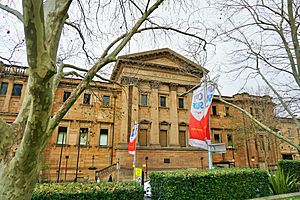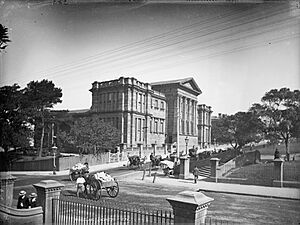Australian Museum facts for kids
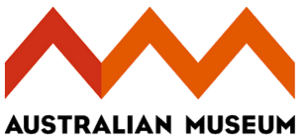 |
|
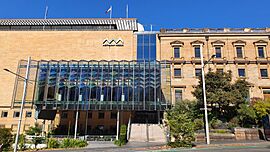
The William Street exterior and Crystal Hall entry to the Australian Museum in 2016
|
|
| Lua error in Module:Location_map at line 420: attempt to index field 'wikibase' (a nil value). | |
| Former name |
|
|---|---|
| Established | 1827 |
| Location | 1 William Street, Sydney central business district, New South Wales, Australia () |
| Type | Natural history and anthropology |
| Public transit access |
|
|
Building details
|
|
| General information | |
| Architectural style |
|
| Construction started | 1846 |
| Completed | 1857 |
| Technical details | |
| Material | Sydney sandstone |
| Design and construction | |
| Architect |
|
| Architecture firm | New South Wales Colonial Architect |
| Official name: Australian Museum | |
| Type: | State heritage (built) |
| Designated: | 2 April 1999 |
| Reference #: | 805 |
| Type: | Other – Education |
| Category: | Education |
The Australian Museum is Australia's oldest museum, located in Sydney, New South Wales. It is also one of the oldest natural history museums in the world. The museum is famous for its work in the fields of natural history (the study of animals and plants) and anthropology (the study of human cultures).
The museum was started in 1827. At first, it was like a giant warehouse for interesting natural and cultural objects. Today, it has amazing collections of animals, both with and without backbones (vertebrate and invertebrate zoology). It also has collections of minerals, fossils (palaeontology), and human artifacts.
Besides its amazing galleries, the museum is a busy center for scientific research. It runs the Lizard Island Research Station on the Great Barrier Reef. There, scientists study how climate change affects coral reefs. The museum's director is Kim McKay, who in 2014 became the first woman to lead the museum.
Contents
The Museum's Story
How It All Began
The idea for a museum in Australia started in 1821. A group called the Philosophical Society of Australasia wanted to create one, but the group did not last long. In 1827, a British official named Earl Bathurst decided to start a public museum in Sydney. This makes the Australian Museum the first of its kind in the country.
In its early days, the museum's main job was to collect items. It gathered many unique objects from Australia and the Pacific. These items helped people in Europe learn about the amazing nature and cultures of this part of the world. The museum has now grown to a collection of over 21 million objects.
Growing and Changing
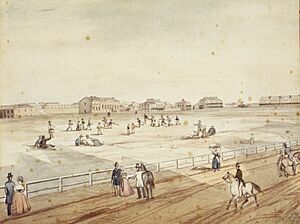
In the 1860s, a scientist named Gerard Krefft became the curator. He helped the museum become known for its important scientific work. For a long time, the museum's galleries were filled with large display cases packed with objects.
In the 1920s, the museum started creating dioramas. These are scenes that show animals in their natural homes. After the 1950s, the museum went through big changes. New buildings were added, and all the galleries were updated to be more exciting for visitors.
In 1978, the museum launched the Australian Museum Train. This two-carriage train traveled across New South Wales. It brought exhibits about nature and evolution to people in regional towns. The train stopped running in 1988, but the museum still connects with communities outside of Sydney.
In 2020, the museum reopened after a major upgrade. This made the museum bigger and better, with new halls and spaces for everyone to enjoy. Best of all, entry to the museum became free for everyone.
The Museum Building
The museum was first located in a government office. It moved several times before settling into its permanent home in 1849. It is located on the corner of William Street and College Street, across from the beautiful Hyde Park.
The oldest part of the building was designed by architect Mortimer Lewis around 1846. It is made of Sydney sandstone and has a classic Greek Revival style. This part of the museum first opened to the public in 1857.
As the museum's collection grew, so did the building.
- 1868: A new wing was added along William Street.
- 1890: A third floor was added to the original wing, making the building look more unified.
- 1963: A modern six-story extension was built. This provided more space for scientists, research, and a library.
- 2008: A new Collection and Research building was added, giving scientists more room for their work.
- 2015: The "Crystal Hall," a glass entrance, was opened on William Street.
- 2020: A major renovation created even more space for exhibitions and visitors.
The building is so important that it is listed on the New South Wales State Heritage Register. This means it is protected as a special part of Australia's history.
Scientific Research
The Australian Museum is not just a place to see amazing things; it is also a hub for scientific discovery.
Lizard Island Research Station
Since 1973, the museum has operated the Lizard Island Research Station. It is located on the Great Barrier Reef. Scientists from all over the world come here to study coral reefs. They work to understand the effects of climate change and find ways to protect this natural wonder.
Australian Museum Research Institute (AMRI)
Launched in 2013, the Australian Museum Research Institute (AMRI) is the center for all the museum's scientists. About 100 scientists and staff work at AMRI. They study everything from the impact of climate change on animals to discovering new species. They work with universities, zoos, and other museums to share knowledge and protect our planet's biodiversity.
Fun Activities and Projects
The museum offers many fun ways for the public to get involved with science and culture.
FrogID Project
In 2017, the museum started a project called FrogID. It asks people all over Australia to use a special app to record frog sounds. These recordings help scientists learn where different frog species live and how they are doing. It is a great example of citizen science, where everyone can help with real research.
In 2022, the project even released an album of frog calls that made it to the Australian music charts!
Nights at the Museum
On some evenings, the museum stays open late for "Nights at the Museum." Visitors can explore the galleries for free from 5pm to 9pm. These nights often include special events with live music, talks, and workshops. One popular event celebrates the cultures of Australia's First Nations peoples.
What to See Inside
The museum has many permanent galleries filled with incredible displays.
- Wild Planet: This gallery features over 400 animals. It tells the story of evolution and shows how all living things are connected on the tree of life.
- Dinosaurs: A favorite for many visitors, this gallery brings the prehistoric world to life with massive skeletons and interactive displays.
- Surviving Australia: Discover Australia's unique and often strange animals and learn about their amazing survival skills.
- 200 Treasures of the Australian Museum: Housed in Australia's first museum gallery, this exhibition displays some of the museum's most important objects. You can see a sled from an Antarctic expedition and a feathered cape given to Captain James Cook.
- Wansolmoana: Opened in 2023, this gallery showcases hundreds of beautiful cultural objects from the Pacific Islands.
- Minerals: See sparkling gems and rare minerals from Australia and around the world in this stunning gallery.
The museum also hosts temporary exhibitions that change throughout the year. These have included everything from ancient Egyptian pharaohs like Ramses the Great to giant dinosaurs from China.
Images for kids
See also
 In Spanish: Museo Australiano para niños
In Spanish: Museo Australiano para niños
- "The New Museum Idea"
- The Lewis Collection
- List of museums in Australia
- List of Natural History articles by Gerard Krefft in The Sydney Mail
- National Museum of Australia
- Museum of Sydney


